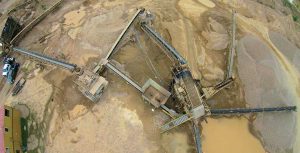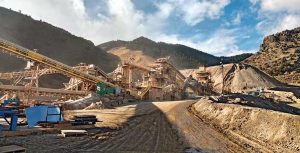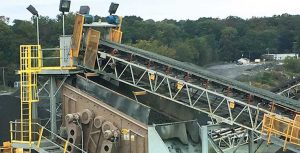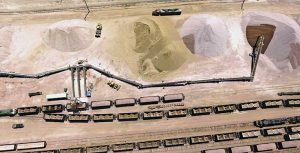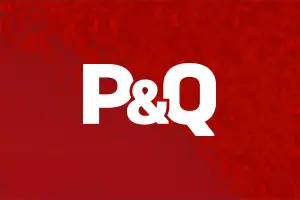Author
Cone crusher boosts production at Cossatot Rock
A user-friendly cone crusher boosts production capacities and plant uptime for Arkansas producer Cossatot Rock. Keep Reading
Screen media system increases quarry’s throughput
Aggregate Industries’ Morrison Quarry manages to meet high demand where throughput is king. Keep Reading
Screening circuits optimize Maryland operation’s process flow
Highly efficient screening circuits optimize productivity and process flow for a Maryland operation. Keep Reading
L.G. Everist unloading system boosts facility production
An Iowa-based aggregate transloading facility boosts productivity with a new unloading system. Keep Reading
Crusher safety enhanced with new technologies
In addition to increasing efficiency, new technologies provide a safer work environment around crushers. Keep Reading
Zip on over: Material handling made easy
Dakota Aggregates LLC, which is in its second season operating a brand new processing plant, mines on 1,722 acres within the University of Minnesota Outreach, Research and Education (UMore) Park. The mine is located in Rosemount, Minn., within reach of the Twin Cities metro area. The operation was designed with innovation in mind, particularly where material handling is concerned. The site spans three miles from north to south, and a mile and a half from east to west. Overland conveyor systems were chosen to efficiently transfer material from the face to the processing facility while eliminating the use of loaders and haul trucks. The conveyors are reportedly quiet while minimizing energy use and lowering operating costs per ton. Initially, the challenge for Dakota Aggregates was finding a lower-cost overland alternative versus that of custom-engineered, conventional overland systems – and, most importantly, one that would allow the company to easily and quickly reconfigure their overland systems to accommodate changing mining requirements each season. Dakota Aggregates has a substantial 40-year lease on… Keep Reading
The permitting process: Part 2
This two-part series educates producers on avoiding pitfalls and adopting best practices in pursuit of obtaining a permit. Read "The permitting process: Part 1" here. Part one of “The Permitting Process” detailed ways aggregate producers could avoid problems while working toward acquiring an operating permit. Part two examines best practices, and begins with the importance of community education and outreach programs. Education and outreach must be ongoing. The industry has long said it must do a better job to educate the public as to the values and contributions of the aggregate and mining industry. This is what helps to build trust and to ease the misconceptions and fears that the public may have, particularly during the permitting process. Few, other than those who work in the industry, truly understand it. Producers who continually implement education programs are in the minority. A quick Internet search regarding quarry education will turn up those producers who are offering tours to school groups and other organizations, teachers’ study guides, educational materials for children, and… Keep Reading
The permitting process: Part 1
This two-part series educates producers on avoiding pitfalls and adopting best practices in their pursuit of permits. Read "The permitting process: Part 2" here. Maneuvering around the potential pitfalls in the permitting process may be likened to playing a fierce round of dodge ball. It takes gamesmanship, mental toughness, negotiation skills, preparation, persistence, and help from a talented team of players. Many are stricken by hit after hit along the way, and, in the end, few are left standing. However, the strong do survive and permits are won. Attaining the hard-fought-for permit is the result of avoiding pitfalls and adopting best practices. Assemble permitting team A common pitfall in the permitting process is failing to assemble a strong, knowledgeable and experienced permitting team – a complete and competent team that oversees the legal, technical, environmental and political approaches regarding the project, the process, the agencies, the government officials and the community. While large producers may have in-house teams that cover each of these areas, most producers do not have the… Keep Reading
Moving mountains with an overland conveyor system
An energy-generating, downhill overland conveyor system boosts safety, savings and sustainability. Moving mountains of upper-ledge rock material to ground-level crushing and processing operations had once posed a significant transport challenge at Geneva Rock Products’ Point of the Mountain site in Draper, Utah. Today, the operation boasts a state-of-the-art material-handling solution with the installation of an innovative downhill conveyor system that meets the company’s key goals of maintaining sound, lowering operational costs and increasing worker safety. Carl Clyde, who serves as the company’s vice president of gravel and asphalt, says that within Utah’s sand-and-gravel industry, this particular downhill conveyor system is unique. The system is particularly unique because it’s designed to generate electricity – enough to ultimately provide power to much of the 50-acre site. “Geneva Rock Products is committed to sustainability, and we find this system to be the most efficient, safe and sustainable way to move aggregate materials,” says Clyde, who adds that the $11 million overland system will pay for itself in two years or less. In the… Keep Reading

